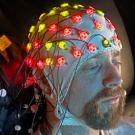
In the garden, butterflies flutter all around and in all directions. The task is to catch them with a virtual net, but only the blue ones. The red ones are a distraction. Sometimes they end up in the net by accident.
The task seems simple, but this experiment in a virtual reality (VR) headset that tracks a person’s eyes, head and hands can explain a lot about how distraction works. The tracking showed that some people caught those distracting red butterflies by accident more often. For people with attention deficit hyperactivity disorder (ADHD), these simple mistakes caused by distractions can add up across their lives.
“We use attention seamlessly hundreds of times a day to gather sensory information and complete tasks,” said Joy Geng, a professor of psychology in the College of Letters and Science at UC Davis. “We often don't think about it until things don't work well.”
The experiment with the virtual garden in her lab at the Center for Mind and Brain was Geng’s first attempt at using VR. Since then, her work with VR has expanded. In collaboration with a colleague at the UC Davis School of Medicine, they are using VR to build a deeper understanding of ADHD. Their hope is that this work will lead to better diagnoses and treatments of attention disorders in children and adults.
Focus and attention deficit hyperactivity disorder (ADHD)
People with ADHD have such a hard time keeping focus that it affects their daily lives. The condition involves a high level of distractibility, and in some, hyperactivity and impulsivity. ADHD affects an estimated 7 million children between 3-17 years old in the U.S., about 11% of all children, according to the Centers for Disease Control and Prevention.
Julie Schweitzer is a professor in the Department of Psychiatry and Behavioral Sciences at the UC Davis School of Medicine and at the MIND Institute. Her team treats children and adults with ADHD. Her patients often struggle in school because they might have trouble keeping track of what their teachers say, or they might even do their homework and completely forget to turn it in.
“Their parent tells them, 'Go get ready for school, go in and brush your teeth,' and they get distracted by something and they never make it to the bathroom,” said Schweitzer.
These kinds of lapses may seem minor, but when they happen over and over their consequences can cascade across a person’s life. Schweitzer said that children who do poorly in school because they can’t focus grow into adults who have a harder time keeping a job, who earn less money and who have car accidents more often. People with ADHD also have higher rates of suicide.
“It just cascades and gets worse and worse. If you're doing poorly in the academic setting that has a lot of implications for what's happening for these individuals later in life.” — Schweitzer
While ADHD has long been the most common childhood behavioral disorder, pediatricians, psychiatrists and psychologists diagnose and treat it with prescribed medication based on subjective rating scales. Parents and teachers rate how attentive a child is, how good they are at following instructions and how often they lose things.
Schweitzer said she has seen surveys vary widely, even from the same parent. A parent might rate their child one way in the waiting room and another way entirely in the consultation office just down the hall.
“Pediatricians are doing the best they can, but the tools we have for diagnosis and treatment are very subjective,” said Schweitzer.
Studying attention with virtual reality to understand ADHD
Geng was collaborating with Schweitzer when she first received a $10,000 gift in 2018 from the Renee and Mike Child Family Fund for the Center for Mind and Brain to incorporate VR into her research at the Center for Mind and Brain. Their new experiment would be based on earlier studies of attention that used eye tracking when people focused on simple stimuli, like dots of different colors arrayed across a computer screen.
“This gift allowed us to dip our toes into this technology to ask very specific questions in virtual spaces that give the participant the feeling that they're in this big naturalistic space." — Geng.
Schweitzer had been collaborating with Albert Rizzo, a psychologist at the University of Southern California where he is also director for medical virtual reality. Rizzo had been using virtual reality technology for years to study distraction in a classroom environment.
“I think this revolutionized how we look at ways of doing something that's artificial but much more similar to what your child would actually experience in real life,” said Schweitzer.
Geng and Schweitzer developed a classroom experiment with a HTC VIVE Pro VR headset bought with the Child Family Fund grant. That model of VR headset was among the first to include eye tracking, which they used to measure distractions with precision. Postdoctoral researcher Jared Stokes built the team’s first virtual experiment using Unity, a virtual reality and video game development platform.
“It's very similar to regular lab-based attention tasks where you're using attention to selectively filter out things in your visual field that aren’t relevant, but now, the child is experiencing this within a classroom that feels more naturalistic,” said Geng.
Measuring attention in the virtual classroom
Since their first experiment with VR, Geng and Schweitzer expanded their collaboration with funding from the National Institutes of Health to deepen their understanding of distractions in a virtual classroom. Just like in a real classroom, the virtual classroom had buses and motorcycles roaring by the window. Cell phones went off, kids whispered to one another, dropped pencils or coughed or sneezed.
All the while, the study’s participant had real work to do on the virtual whiteboard. It could be math, reading or a standard attention task. The eye tracking measured where they looked and for how long so it was clear how distracted they were by each surprise.
Geng and Schweitzer published the results of that study in 2022, which suggested that children with attention deficits may have a hard time returning to tasks once those tasks are interrupted, even if the initial distraction itself doesn’t keep their attention.
“Just learning that distraction can be protracted for much longer than we thought helps us understand what distractibility looks like,” said Schweitzer. “Having these really precise measures with eye tracking, we can see where their eyes are going and it gives us a much better understanding of what happens each time a distraction appears.”
Results could improve assessments and treatment of ADHD
Improving assessments of ADHD is where Schweitzer sees the biggest opportunity in working with Geng. Their complementary skillsets as researchers are driving forward a better understanding of attention while also helping to build more objective tools for diagnosing ADHD. In September 2024, they won a new National Institutes of Mental Health grant to study distraction in academic settings among teens with and without ADHD.
“We need to understand attention better because understanding attention will hopefully lead to better diagnostic practices. We're not there yet.” — Schweitzer
In March 2025, Geng received another grant from the National Science Foundation to forge ahead with her VR research in average adults. This new project will build a deeper understanding of how we use visual attention during tasks like looking for keys, searching the store for items on our shopping list or finding a friend in a crowd. This research will also provide insight on why the processes underlying these tasks might go wrong.
“The hope is that if we can better understand the different mechanisms that go into each decision point during a visual search, we will be able to use that information to better diagnose or better treat things like ADHD,” said Geng.
YOU MAY ALSO LIKE THESE STORIES

Asthma May Place Children at Risk of Memory Difficulties, New Research Finds
Asthma is associated with memory difficulties in children, and early onset of asthma may exacerbate memory deficits, according to a new study from the College of Letters and Science. The study is the first of its kind to connect asthma to memory deficits in children.

$900K NSF Grant to Help Researchers Probe the Cognitive Brain Mechanisms Behind Free Will
Funded by a three-year $900,000 grant from the National Science Foundation, Distinguished Professor George R. Mangun, director of the UC Davis Center for Mind and Brain, is launching a project to better understand the cognitive mechanisms behind realistic voluntary attention, or attention directed by an individual’s free will.
